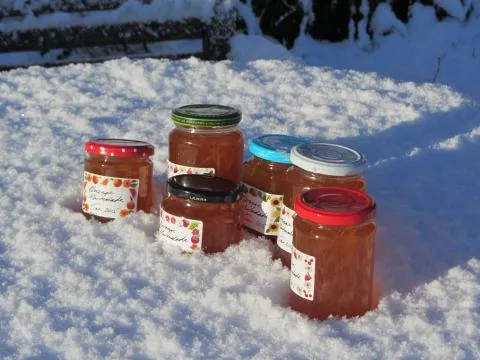
I've been making marmalade for at least 10 years using this method - passed down from my mum - and it's never failed. It involves a fair amount of work but you'll be thanking yourself for the rest of the year because it creates the most tangy, refreshing marmalade and you'll struggle to go back to shop-bought stuff.
I'm going to give you the detailed version - with as many helpful tips as I can. So here are my 13 steps to marmalade heaven - the perfect January pick-me up.
Equipment
-Sharp knife (serrated is best for cutting orange skin)
-Chopping board
-Citrus fruit juicer (I use a plastic one that I bought for 50p)
-Jam jelly bag or muslin - fine-meshed material that will hold the pith and pips
-Large pan
-10 clean jars (sterilized - including lids)
-Broad-mouthed jam funnel
Ingredients
2lbs Seville oranges (these are only in the shops in January and early Feb)
1.5 lemons
1 sweet orange
4 pints water
4lbs granulated sugar
Instructions
1. Put the radio on.
2. Cut all the oranges (including the sweet orange) and the lemons in half. Then juice them. Reserve the juice in a large bowl. Put any pips into the muslin/jelly bag.
3. Scrape out the remaining pith and pips from the fruit and put them all into the muslin/jelly bag. I use a metal desert spoon and with a bit of practise can remove all the pith in one go. You should now be left with the hollow skins/peel of the fruit.
4. Tie or clip the muslin mag shut and add it to the bowl with the juice. This bag of pith and pips contains pectin, a natural setting agent. When you boil it with the marmalade, the pectin is extracted and helps it set.
5. Chop the orange and lemon peel. I tend to slice it to about 2cm long and no more than 2mm wide but it's up to you. It's impossible to make it uniform. Just don't go too big. It's time consuming so put on a long album or tune into a radio play.
6. Put the chopped peel into the same bowl as the juice and muslin bag and add the 4 pints of water. Leave for 24 hours. This helps soften the peel and the pith.
7. 24 hours later, put your raw marmalade into a large pan and boil rapidly. This is the trickiest bit. You want to boil off about half of the liquid, by which time the peel should be soft enough to disintegrate if rubbed between two fingers.
8. While you're boiling the marmalade, warm the sugar in the oven - about 90°C for 20 minutes should do it. This helps it melt faster when you add it to the boiled down raw marmalade. Put a couple of small plates in the freezer - you'll need these to test when the marmalade is at setting point. Put your jam jars in the oven too - warming them up will prevent them from shattering when you 'jar up' you molten lava marmalade.
9. When you think you're ready, remove the bag of pith and pips and give it a squeeze (wear gloves it's boiling). You'll see the sticky pectin oozing out and you want that in the marmalade. Set the bag aside.
10. Add the sugar and bring to a rolling boil - not too furious. Now boil for 10 minutes and then start testing. Stir the marmalade to ensure all the sugar is dissolved. It should take on a lovely dark orange molten lava look and feel.
11. Dribble some of the marmalade onto one of the cold plates. After a minute, run a finger through it; if it wrinkles, the marmalade is ready. If not, boil for another 5-10 minutes and test again.
12. When your test sample wrinkles, take the marmalade off the heat and leave for 10 minutes to rest. Then put it into jars - I use a big soup ladle and a broad-mouthed funnel.
13. Put on the lids (wear gloves the jars will be hot). Turn upside down - this seals the jars and sterlises the underside of the lid one last time. It also save on the faff of using wax paper and fiddly plastic film covers.
14. There will always be a bit left over that won't quite fill your 9th or 10th jar. Eat this on toast immediately. Enjoy the rest for breakfast for months to come.

